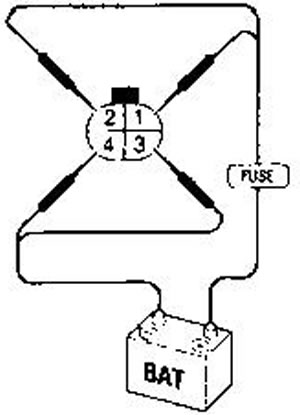ECM relay
The relay is located under the engine control unit, and is used to remove voltage from part of the ECM circuits on a signal from the unit itself. To test the relay, disconnect its connector and apply 12 V to pins 1 and 2. Pins 3 and 5 should close.
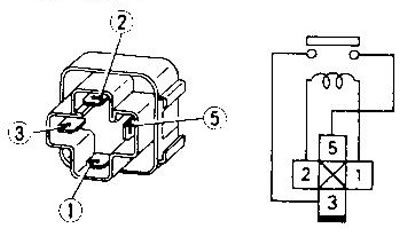
Camshaft Angle Sensor (fault count 11)
The sensor is a disk with 360 slots at 1°for the position signal and 4 slots for the reference signal at 180°. On GA motors for Europe, the disc does not have 1°slots for position signal. The disc slots pass through two optocouplers, consisting of an LED and a photodiode. Light pulses are converted by photodiodes into voltage pulses and fed through the leveling circuit to the ECM.
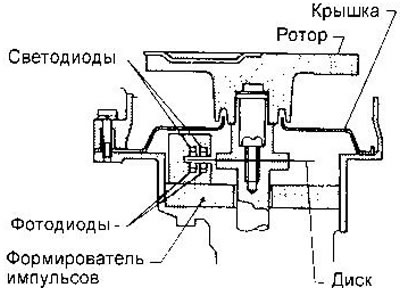
When you receive a fault number 11, you must first perform its confirmation procedure. Start the engine (crank the starter) for at least 2 seconds, then turn the ignition off for at least 7 seconds and then on again. Set diagnostic mode II and get a trouble code. If the fault is confirmed, check the sensor as follows (it is assumed that the wires and connectors, as well as the control unit are working):
1. Start the engine.
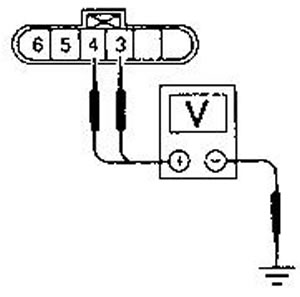
2. Check the voltage between ground and pins 3 and 4 on the AC voltage range. The voltage should be around 2.7V (this is the average value for a pulsed signal: the waveform can be seen with an oscilloscope). On GA motors for Europe, only pin 4 is signaled.
3. Remove the distributor cap and visually inspect the disc for damage or contamination.
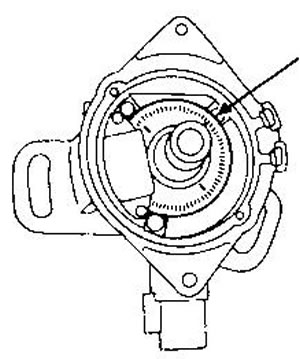
After the malfunction has been eliminated, code No. 11 may still be issued. Erase it from memory.
Mass air flow sensor (fault code 12)
Mass air flow sensor (MAFS - Mass Aig Flow Sensor) is a fire wire located in a separate channel through which part of the air passes. The wire is heated by electric current to a certain temperature. Since the cooling of the wire depends on the air flow, to maintain a constant temperature, it is necessary to change the current through the wire. A signal proportional to the current through the wire; submitted to the ECM.
To confirm DTC No. 12, turn on the ignition, then after at least 6 seconds, start the engine and wait at least 3 seconds. Switch off the ignition and switch it on again after at least 7 seconds. Set diagnostic mode 11 and get a trouble code.
Checking the sensor is performed as follows (it is assumed that the wires and connectors, as well as the control unit are working):
1. Turn on the ignition.
2. Start and warm up the engine.
3. Check the voltage between pin 1 and ground. At idle with a sufficiently warm engine, the voltage should be in the range of 1.2-1.8 V. With the engine stopped and the ignition on, the voltage should be less than 1.0 V.
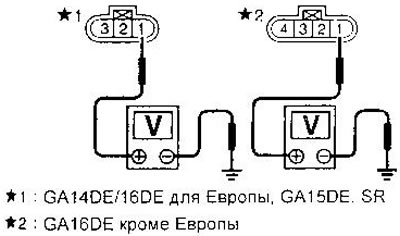
4. If the voltage is not within the specified limits, remove the sensor and check the condition of the wire. It must not be damaged or contaminated.
coolant temperature sensor (fault code 13)
coolant temperature sensor (ECTS — Engine Coolant Temperature Sensor) is a thermistor whose resistance! temperature dependent. Supply voltage is applied to the resistor with the ECM.
To confirm DTC #13, turn the ignition on, wait at least 5 seconds, turn the ignition off for at least 5 seconds, and turn it back on. Set diagnostic mode II and get the fault number.
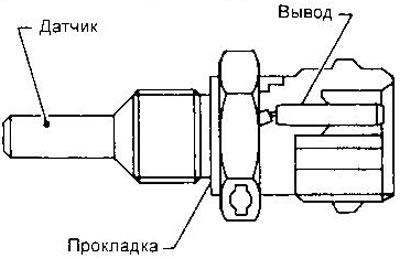
To check the resistance of the thermistor, unscrew the sensor and lower it into a heated bath of water:

Ignition coil and key transistor (fault code 21)
The ignition coil is built into the distributor. The signal from the ECM controls the key transistor, through which a current pulse flows into the primary winding. In this case, a high voltage is induced in the secondary winding.
If fault codes 11 and 21 are received at the same time, first eliminate the cause that caused code 11.
To confirm DTC No. 21, turn on the ignition, turn off the engine (if it does not start, hold the key in the START position for at least 5 seconds), turn off the ignition, wait at least 7 seconds and turn it on again. Set diagnostic mode II and get a trouble code.
To check the ignition coil, disconnect this connector (two-contact, on the side of the distributor) and measure the resistance between the contacts. Contacts 7 and 8 are the terminals of the primary winding, the resistance between them at 25°C should be about 1 ohm (0.5-1.0 ohm for SR motor).
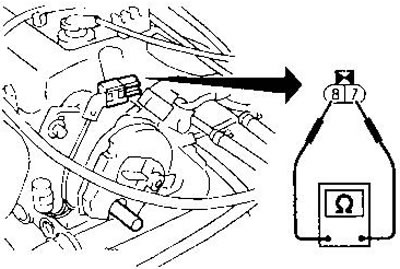
To check the secondary winding, remove the distributor cover. The output of the secondary winding is a metal pin. The resistance between it and pin 7 should be at 25°C about 10 kΩ for GA motors and 25 kΩ for SR motor.
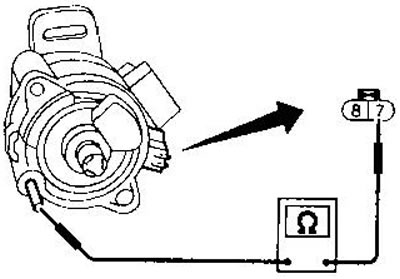
To check the key transistor, disconnect its connector (on the side of the distributor) and measure the resistance between pins 2 and 8. If it is not 0, the transistor is good. Bullet resistance speak) breakdown of the transistor. The distributor must be replaced. (The figure shows the location of the connectors for GA motors).
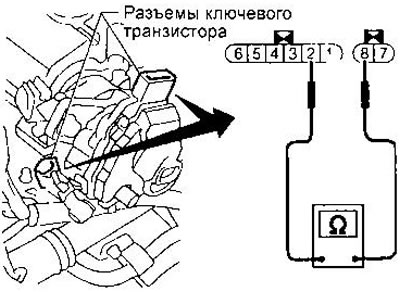
To check the resistor, disconnect its connector and measure the resistance between pins 1 and 2. The resistance should be about 2.2 kOhm (at 25°C).
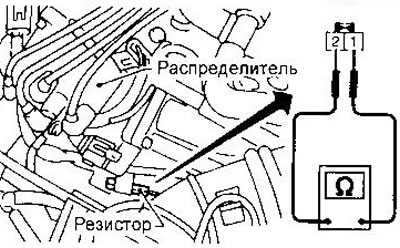
Knock sensor (fault code 34)
Knock sensor (KS — Knock Sensor) attached to the cylinder block. It contains a piezoelectric element that reacts to the vibration of the cylinder block during detonation. When the piezo is compressed, a voltage is generated which is applied to the ECM.
To confirm DTC 34, run the engine for at least 5 seconds. Switch off the ignition, wait at least 7 seconds and switch it on again. Set diagnostic mode II and get a trouble code.
To check the sensor, an ohmmeter with a measurement limit of more than 10 MΩ is required. Disconnect the connector from the sensor and measure the resistance between pin 2 and ground. It should lie in the range of 500-620 kOhm,

WARNING:
- Do not use a sensor that has been dropped or subjected to shock.
- Inlet air temperature sensor (fault code 41).
Inlet air temperature sensor (IATS — Inlake Air Temperature Sensor) attached to the air cleaner housing. It is a thermistor, the voltage with which is supplied to the KSM. This sensor is not used directly for engine control, but only for on-board diagnostics.
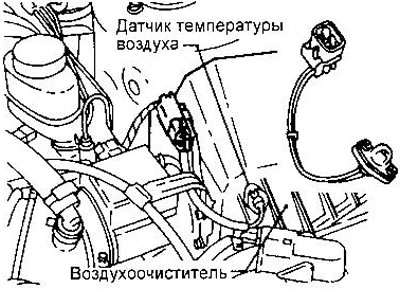
To confirm DTC #41, turn on the ignition and check the coolant temperature. It should be no more than 9CGS. For a more accurate temperature reading, measure the voltage on track 51 of the ECM connector. It should be over 1.2 volts. If not, turn off the ignition and wait for the engine to cool down. Then turn the ignition on for at least 5 seconds, turn it off, wait 3 seconds and turn it on again. Set diagnostic mode II and get a trouble code.
To check the resistance of the sensor, remove it and lower it into a heated bath of water.
At a temperature of 20°C, the resistance between the contacts of the connector should be within 2.1-2.9 kOhm, and at a temperature of 50°C - within 0.68-1.0 kOhm.
Throttle position sensor (fault code 43 in SR engine) - checking and adjusting
The throttle position sensor is a variable resistor whose moving contact is connected to the throttle valve. A moving contact voltage proportional to the throttle opening angle will be applied to the ECM. In addition, with the help of this sensor, the speed of opening or closing the throttle valve is determined.
To check the sensor, turn on the ignition and measure the voltage between terminals 20 and 21.29 (weight) ECM connector. The voltage should be about 0.35-0.65 V when the pedal is fully released and increase linearly to about 4-4.5 V when it is depressed.

To check the variable resistor of the sensor, disconnect its connector and measure the resistance between pins 2 and 3. With the damper fully closed, it should be about 0.5 kOhm in GA motors (1 kΩ in SR motor), gradually increase when the damper is opened and reach a maximum value of about 4.0 kΩ in GA motors (10 kΩ in SR motor).
Adjustments. With the accelerator pedal fully released, turn the sensor housing to set the voltage at its output to 0.5 V. After that, recalibrate. To do this, warm up the engine, turn off the ignition and not earlier than after 5 seconds, disconnect the connector from the sensor. Then start the engine, wait at least 5 seconds (the gearbox must be in position N) and connect the sensor connector with the engine running.
Speed sensor
Vehicle speed sensor (VSS Vehicle Speed Sensor) installed in the gearbox. It contains a pulse generator, the repetition rate of which is proportional to the speed of movement. The signal from the speed sensor is fed to the speedometer, and from it to the engine control unit.
To test the sensor, raise the front of the vehicle and rotate the front wheel to measure the voltage on pin 32 of the ROM. 11 voltage must be in the range 0-5 V (see also chapter «electrical equipment», «instrument cluster»).**
Nozzles
The injector is a small precision solenoid valve with a spray that opens when the coil is shorted to ground through the ECM. The amount of injected fuel is determined by the duration of the control pulse.
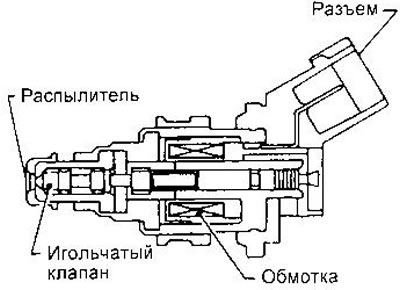
To check the injector with the engine running, attach a tool to its body (e.g. a screwdriver), the end of which is brought to your ear. The nozzle should make a clicking noise.
To check the solenoid winding, disconnect the connector from the injector and measure the resistance between the terminals. It should lie in the range of 10-14 ohms (at 25°C).
Fuel pump
The fuel pump is turned on by the control unit immediately after the ignition is turned on to create the necessary fuel pressure. If the ECM does not receive a signal from the camshaft position plate, the pump will turn off after 5 seconds to avoid battery drain and improve safety. After the engine stops, the pump turns off within 1 second. The pump is controlled via a relay. The fuel pump relay is located under the instrument panel on the driver's side.
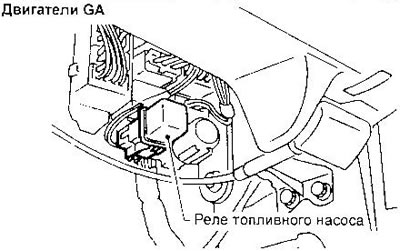
To check the operation of the pump, squeeze the hose that fits the fuel filter in the engine compartment with your fingers and turn on the ignition. Pressure pulsations should be felt within 5 seconds.
To test the relay, remove it and apply 12 V to pins 1 and 2. Pins 3 and 5 should then close.
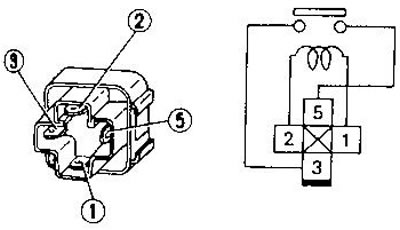
To check the pump itself, remove the inspection hatch under the rear seat, disconnect the pump connector and measure the resistance between pins 1 and 2. It should be 0.2-5.0 ohms (at 25°C).
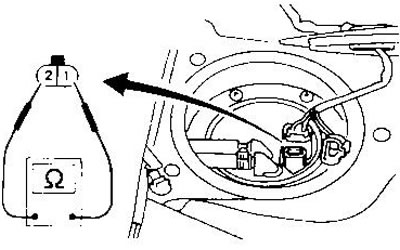
IACV-AAC valve
Control valve for supplying main and additional air at idle (Idle Air Control Valve — Auxiliary Air Control) designed to control the engine idle speed. Optimum RPM stored in ECM memory for different engine operating conditions (warming up, engine braking, turning on the air conditioner, etc.).
The flow area of the valve changes according to the signal from the control unit. This changes the amount of air that bypasses the throttle, and hence the idle speed.
In addition to the IACV-AAC valve, the IACV-FICD valve is also installed (Fast Idle Control Device), designed to increase the air supply when the air conditioner is turned on.
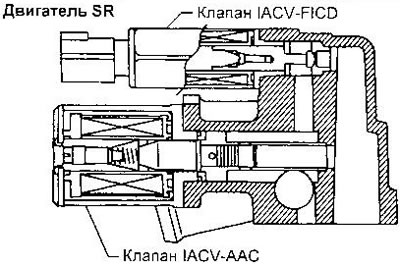
To test the IACV-AAC valve in GA engines (except Europe), disconnect the valve connector and measure the resistance between pins 2 and 3, 3 and 4. It should be between 50-100 ohms (at 25°C).
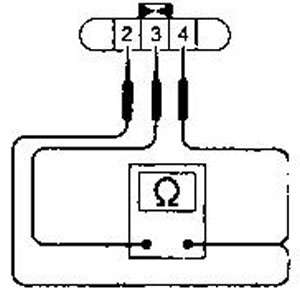
To test the IACV-AAC valve on GA engines for Europe, disconnect the valve connector and measure the resistance between its contacts. It should be about 10 ohms (at 25°C).
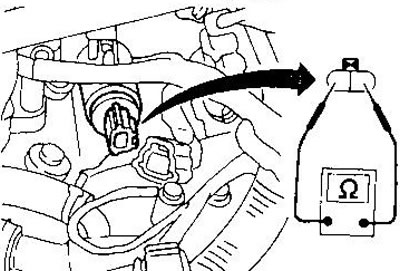
After removing the valve, check if the plunger is sticking. The O-ring and gasket must be replaced each time the valve is removed.
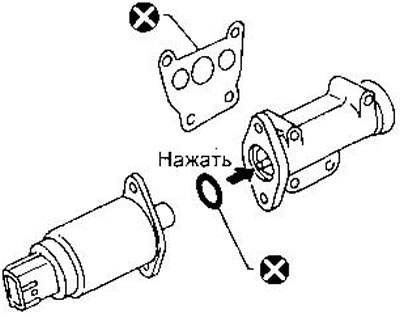
To test the operation of the IACV-FICD valve, start and warm up the engine, then measure the engine speed at idle. If it is different from normal. make adjustment (see relevant section of this chapter). Then turn on the air conditioner. Turnover should increase to 850-900 min-1 or more, depending on the engine model.
To test the IACV-FICD valve in GA engines (except Europe) disconnect its connector and measure the resistance between pins 1 and 5. It should be in the range of 75-125 ohms (at 25°C).
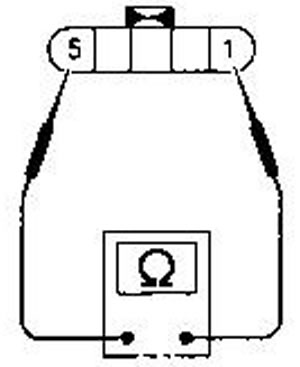
On European GA and SR engines, disconnect the valve connector and apply battery voltage to it through the fuse gel. A clicking sound should be heard. If clicks are not heard, remove the valve and check if the plunger is sticking and if the spring is broken.
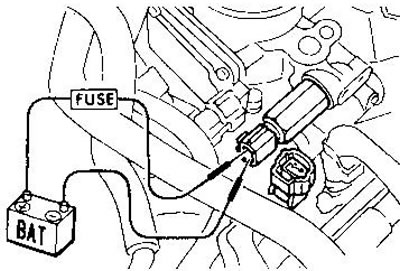
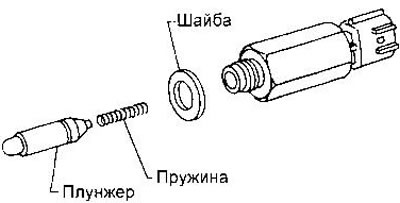
Canister purge valve
In GA engines, as well as in SR engines up to 04.96, this valve is also used to control the EGR valve and is called the recirculation and canister purge valve (EGR Valve and EVAP Canister Purge Control Solenoid Valve). When the solenoid winding is shorted to ground through the ECM, the vacuum from the throttle pipe stops being supplied to the recirculation valve and canister.
To check the valve, apply battery voltage to the one hundred connector through the fuse. This should open the channel between inlets A and C. B and close the channel between inlets A and C. The SR engine for Europe from 04.96 does not have inlet C, so only the air flow between inlets A and B needs to be checked.
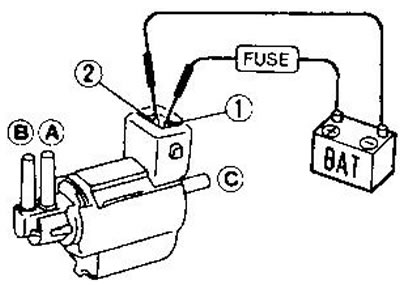
Recirculation valve
recirculation valve (EGR — Exhaust Gas Recirculation valve) used to supply part of the exhaust gases from the exhaust manifold to the intake manifold. The degree of opening of the valve is determined by the vacuum applied to it. Vacuum is supplied through the recirculation valve and adsorber purge (see above).
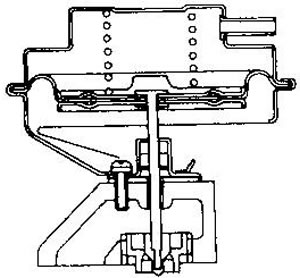
To check the valve, apply a vacuum from a hand vacuum pump to its inlet and check if the diaphragm rises.
EGRC-BPT valve
Used to change the vacuum applied to the recirculation valve, depending on the pressure of the exhaust gases.
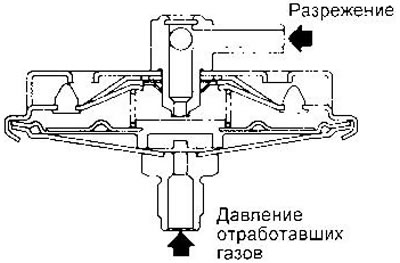
To check the valve, close one of its vacuum inlets, apply a vacuum to the second one and check that there are no leaks and pressures D 9 8! kPa at the bottom inlet.
Power steering oil pressure sensor
This sensor is connected to the power steering high pressure circuit and is designed to determine the load on the power steering. When the steering wheel is turned, the pressure in the booster will increase, the sensor contacts close and the ECM increases the Islam of air through the IACV-AAC valve to increase the idle speed and adapt the engine to increased load.
When the steering wheel is turned quickly, there should be a voltage of about 0 V on track 43 of the ECM connector, in other cases - about 5 V (8-10V in SR up to 04.96).
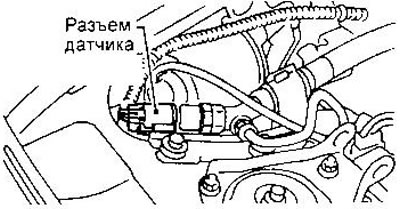
Oxygen sensor (heated)
The oxygen sensor is installed in the exhaust manifold. It determines the oxygen content in the exhaust gases in relation to the atmospheric air. The sensitive element of the sensor is a zirconium ceramic tube. The potential of the tube varies from about 1 V (lack of oxygen) up to 0 V (excess oxygen). The optimal composition of the mixture corresponds to the point of a sharp change in the potential.
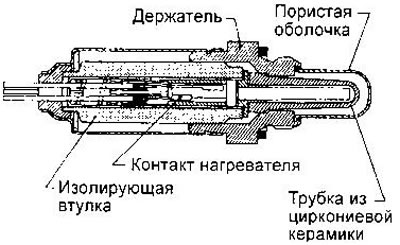
Checking the oxygen sensor is described in the section of this chapter on checking and adjusting idle speed.
Yes, I check the heating gel, measure the resistance between pins 1 and 3 of the sensor connector. It should be 2.3-4.3 ohms at 25°C (3.3-6.3 ohm in SR motor).
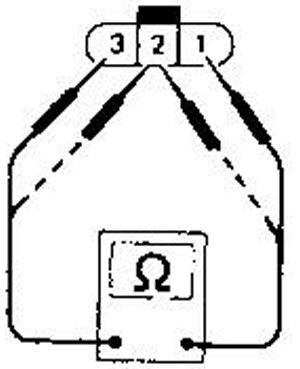
Valve timing adjustment
Valve timing system (VTC — Valve Timing Control) is designed to change the moments of opening and closing of the intake valves, depending on the current operating conditions of the engine.
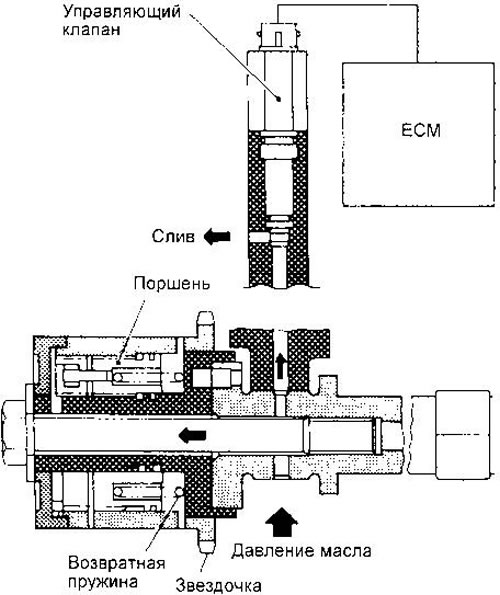
The position of the drive sprocket relative to the intake camshaft depends on the oil pressure, which is controlled by the valve. controlled by the ECM.
To test the valve, apply battery voltage to its connector through the fuse. In this case, the plunger should move forward.
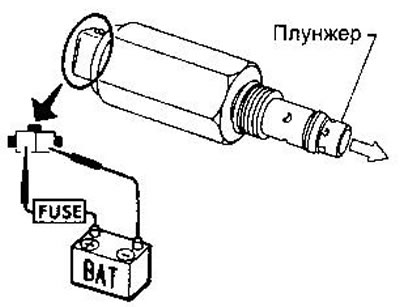
Fast idle cam
GA engine for Europe. To check the operation of the fast idle cam, start the engine and warm it up to a coolant temperature of 80 = 5°C. To measure the temperature, disconnect the connector from the temperature sensor and attach an ohmmeter to it. The desired temperature is reached with a sensor resistance of 0.26-0.39 kOhm. Check whether the marks A and C are aligned. If necessary, align the marks with the adjusting screw. The screw tightening torque is 0.98-1.96 Nm.
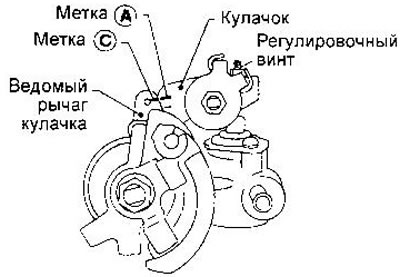
Stop the engine. Wait until the liquid temperature drops to 25±5°C (sensor resistance should be 1.65-2.40 kOhm). Check the alignment of marks B and C. If they diverge, replace the fuser and repeat the above check and adjustment.
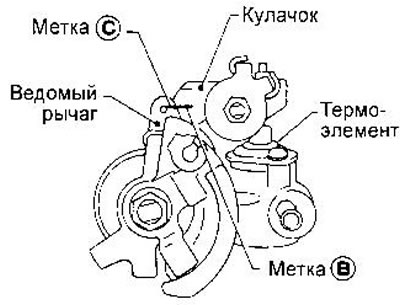
SR engine for Europe from 04.96. Remove the throttle body (see chapter «Engine», chapter «External Components»). Hold the orifice for at least 3 hours at ambient temperature to equalize air and thermocouple temperatures (wax filler).
Without removing the thermocouple from the throttle tube, measure the length L. If it is within the shaded area, the thermocouple is OK. Adjust the cam as described below. Otherwise, replace the thermocouple.
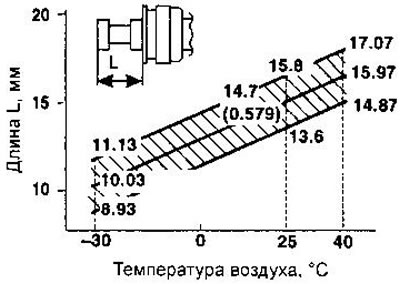
Check the gap A between the limiter and the throttle adjusting screw. If it is not within the shaded area, adjust with screw S. Do not turn the throttle adjusting screw.
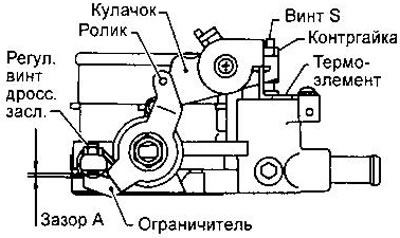
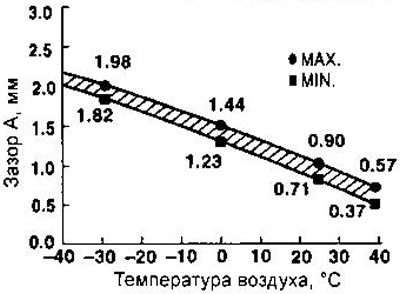
After adjusting gap A, tighten the locknut of screw S.
Install the throttle tube. Start and warm up the engine. Make sure there is a gap between the cam and the roller.
Fan
Manual transmission models have single speed fans, automatic transmission models have two speed fans.
To test the fan relay, apply battery voltage through the fuse to pins 1 and 2, then check that pins 3 and 5 are closed (relay with one group of contacts) or 3 and 5, 6 and 7 (relay with two groups of contacts).
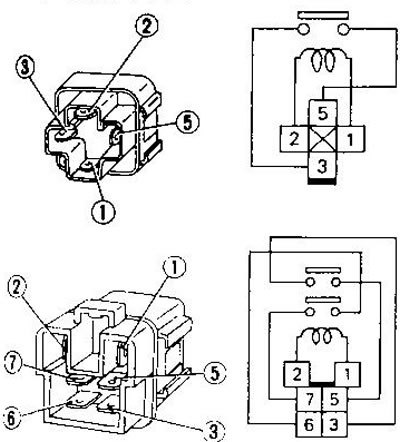
To test a single speed fan, apply battery voltage to its connector pins: "+" to pin 1, "-" to contact 2.
To test the two-speed fan on GA motors, apply battery voltage to the following terminals: "+" to pin 1, "-" to pin 4 (low speed); "+" to pin 2, "-" to pin 3 (high speed).
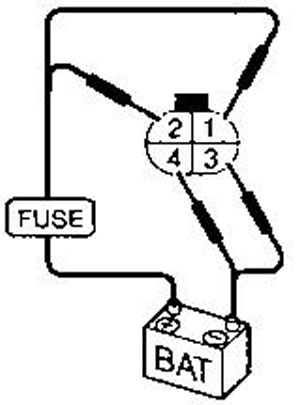
On SR motors, high fan speed requires a "-" to pins 1 and 2, "+" to pins 3 and 4.
